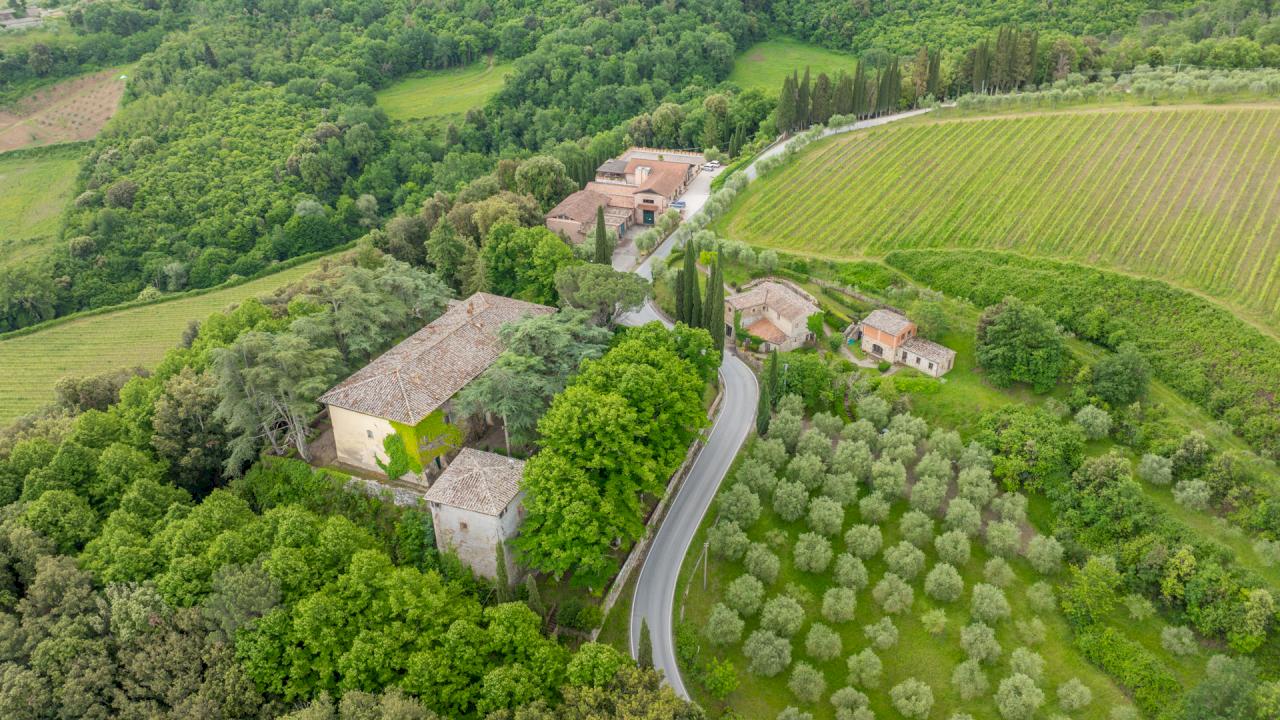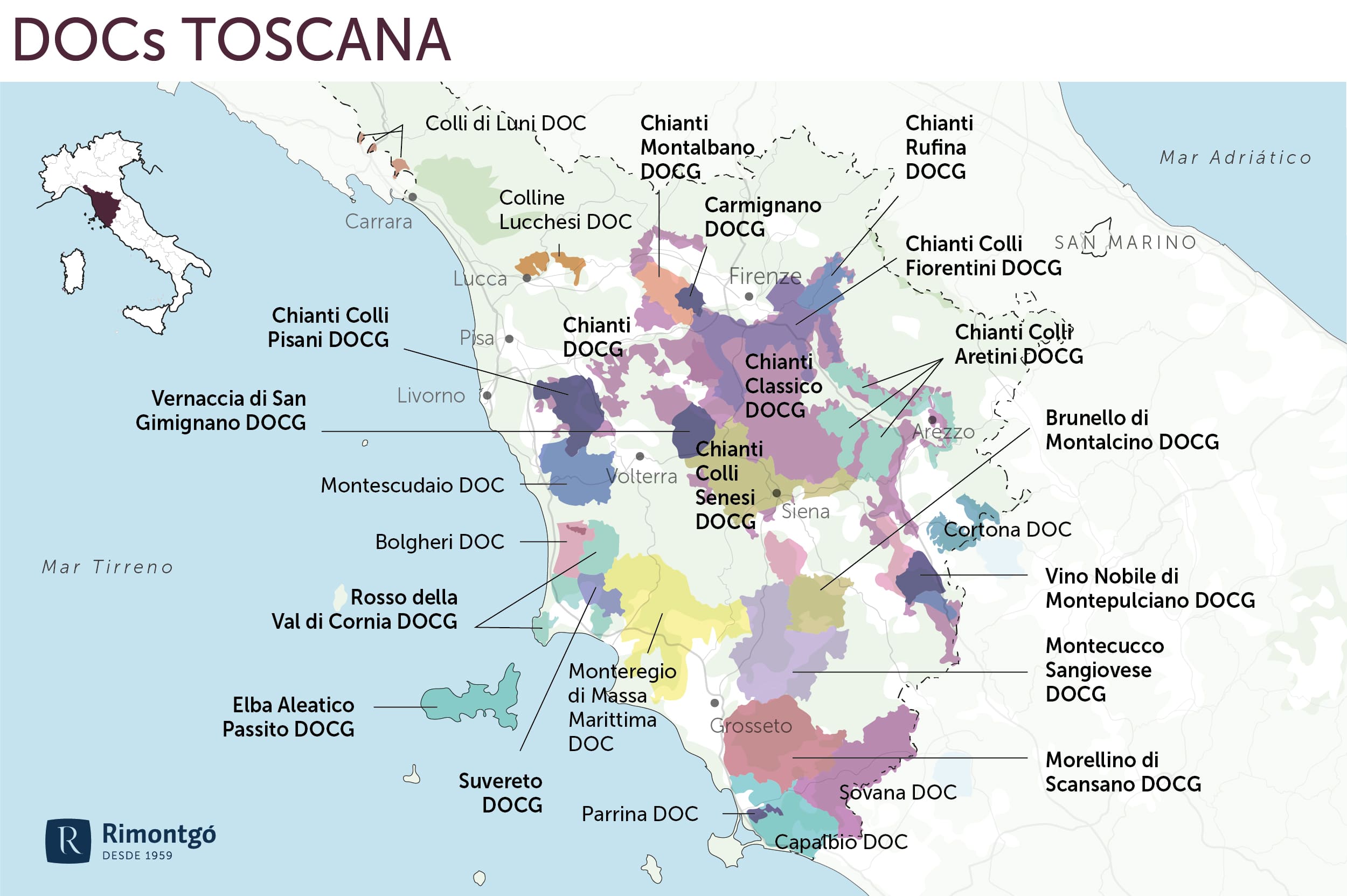Find your winery or vineyard
1 Wineries and Vineyards for sale in Florence

Castle with historic wine estate in the heart of Chianti Classico.
CHIANTI CLASSICO DOCG
Infographic of the Denomination of Origin

Change to imperial units (ft2, ac, °F)Change to international units (m2, h, °C)
D.O. year of foundation:
1924
Number of wineries (2017):
243
Total surface area:
6.800 ha16.803 ac
Maximum production allowed:
7.500 kg/ha6.691 lb/ac
Altitude of the vineyards:
Min: 150m
Max: 650m
Min: 492ft
Max: 2.133ft
Temperature:
Min: 4º
Max: 35º
Min: 39°F
Max: 95°F
Yearly hours of sun:
3.772
Yearly rainfall:
921 l/m286 l/ft2
Florence
Florence is a city located in the north of the central region of Italy, capital of Tuscany, of which it is the historical, artistic, economic and administrative centre.
It experienced its period of greatest splendour after the establishment of the Grand Duchy of Tuscany under the rule of the Medici dynasty. Florence is the urban centre where the artistic movement known as the Renaissance originated in the second half of the 14th century, and is considered one of the world's cradles of art and architecture, as well as one of the most beautiful cities in the world.
HISTORY OF WINE
The history of vine cultivation in Florence is written from the Etruscan settlements of the 8th century BC, through the literary references of Greek writers about the high quality of their wines until the fall of the Roman Empire. In the Middle Ages, monasteries, as in most of Europe, were the main wine producers in the region. When the aristocracy and merchants emerged, there were many Tuscan landowners who produced wine which they sold to merchants in Florence. The first reference to Florentine wine merchants is from 1079, and in 1282 their first guild, called Arte dei Vinattieri, was established, which laid down rules on how Florentine wine merchants should conduct their business.
By the 14th century, an average of 300,000 hectolitres of wine were sold annually in Florence. The first recorded mention of Chianti wine is known to be by a Tuscan merchant named Francesco di Marco Datini, the "merchant of Prato", who described a wine that would become world famous.
Almost all noble Florentine families were involved in wine production. In the palaces of the old town you can read the names of families such as: Antinori, Capponi, Frescobaldi, Ginori, Gondi, Contini Bonacossi, etc…
In some of these palaces you can see, at eye level and below the windows, some curious small doors of minimal size (23 cm x 36 cm) to pass a carafe of wine through. Called “Buchette del vino”, they were used to sell wine.
There are about 170 such windows in the city of Florence, which bear witness to the long wine-making tradition of the city and its countryside.
WINES AND WINERIES
Chianti is the largest classified Tuscan wine region and produces Chianti red, as well as white wines, other reds (rossos) and vin santo. The region is divided into 2 DOCG denominations: Chianti and Chianti Classico, the second having the most famous wines.
Another wine worth mentioning is the wine known as “vin santo”, which is mainly white as it is used as a dessert wine. The most famous version comes from Chianti Classico and is made by blending Trebbiano and Malvasia Bianca grapes. Red and rosé styles are also produced mainly from Sangiovese grapes and are known as “eye of the partridge”, occhio di Pernice.
Carmignano DOCG, in the province of Prato, famous for the quality of its wines since the Middle Ages, was identified by Cosimo III de' Medici, Grand Duke of Tuscany, as one of the superior wine-producing regions, granting it special legal protections in 1716. In the 18th century, producers in the region developed the tradition of blending Sangiovese with Cabernet Sauvignon, long before this custom was popularised by the "Super Tuscans" in the late 20th century. Today Carmignano has approximately 110 Ha planted, producing almost 2,700 hl of DOCG designation each year.
Chianti Classico DOCG. The symbol of Chianti Classico is a Black Rooster.
In 1716, Grand Duke Cosimo III de' Medici created the Chianti League, which defined the original boundaries of the Chianti wine-growing area. This early effort to regulate wine production underscored the region's commitment to quality, a tradition that continues today. In the 19th century, Baron Bettino Ricasoli (1809-1880) defined the production standards for Chianti. This marked the beginning of its rapid rise to winemaking power. Over the centuries, Chianti has become a symbol of Italian excellence, celebrated for its distinctive red wines made primarily from Sangiovese grapes.
Chianti Classico DOCG is produced in the most traditional Chianti region, located along the valleys between Florence and Siena, and is embodied by the historic black rooster that graces its wine labels. In this region, the production of wines under the Chianti DOCG designation is not permitted, and its producers aim to showcase a more elegant and structured style of wine, wines capable of competing with the opulence of the greatest Sangiovese wines in the region.
In fact, Sangiovese wines, with a minimum proportion of 80% or entirely single-varietal, as most are, constitute the backbone of this appellation, the true common element in all these terroirs, so distinct due to the diversity of climates and soils, such as those found in Castelnuovo Berardenga, Castellina, Radda, Gaiole, or Greve.
Chianti DOCG.
The history of Chianti dates back to the Etruscan civilization, which flourished in central Italy long before the rise of the Roman Empire. The fertile hills of Chianti offered ideal conditions for growing grapes and olives, laying the foundation for the region's agricultural heritage. By the Middle Ages, Chianti had become a strategic area for trade and defense, characterized by its picturesque castles and fortified villages. Chianti is the most popular Italian red wine.
The history of this DOCG indirectly begins in 1716; it was then that Grand Duke Cosimo III, Grand Duke of Tuscany, classified the strip of land between the cities of Florence and Siena, giving rise to the Chianti region and the wine of the same name, which was already very popular at the time. At the beginning of the 20th century, when the production of this pioneering region failed to meet national and international demand, the area expanded beyond the territory between Florence and Siena, encompassing both provinces of the same name, temporarily retaining the name Chianti. This changed in 1932: a ministerial decree designated the Chianti produced in the traditional area as Classico, while producers in the subsequently expanded areas retained the simple term Chianti.
Chianti Colli Fiorentini DOCG
Formed by 15 Municipalities, located in the Florentine Hills area. DOCG and IGT of Sangiovese, Cabernet, Sauvignon, Canaiolo nero vines. Empolese White Wines, Vino Santo dell'Empolese, Central Etruria Hills, Pomino.
Chianti Rufina and Pomino DOCG
Rùfina is the smallest of the Chianti DOCG sub-areas. The production area includes the municipalities of Dicomano, Londa, Rufina, Pelago and Pontassieve, all located on the hills east of Florence. The territory is characterized by high hills and a harsher climate than the other Tuscan wine areas. You can admire medieval castles and villages, historic gardens, farm roads and splendid vineyards. Chianti Rufina DOCG and Vino Santo DOC.
Under the reign of Cosimo III, in 1716, two distinct areas (Carmignano and Chianti) were demarcated, as was Pomino, which is among the first appellations of origin in Europe. The Pomino region, near Ruffina, has historically been known for its predominance of French grape varieties, producing wines ranging from Cabernet Sauvignon to Chardonnay, Merlot, Pinot Blanc, and Pinot Grigio, in addition to local Italian varieties. The Frescobaldi family is one of the region's most important wine producers.
Vin Santo DOCG
This is a sweet wine traditionally produced in Tuscany. In the Pieve di Campoli in the province of Massa-Carrara, the harvest of the grapes has great symbolic meaning, as the vineyards have belonged to the Church for centuries. This wine has been used in the Cathedral of Florence for mass and is a typical drink in Tuscan homes.
The “vinsantaie” are the most emblematic of Chianti. These are well-ventilated spaces where the grapes are left to dry naturally, an essential process in the production of Vin Santo.
Vin Santo has historical roots that date back to the 14th century, during the black plague that ravaged Europe. It is said that a Dominican friar used this wine to relieve the suffering of the sick, leading to the popular belief that it had miraculous properties.
At the Council of Florence in 1439, a grand banquet hosted by the Medici was held, where a raisin wine was served. Cardinal Bessarione, upon tasting it, exclaimed “Hoc Xanthos est!” (referring to a golden wine from Santorini), which was interpreted as “Vino Sanctus” or “Holy Wine”.
Super Tuscans
Characteristic of this area is the emergence of the category of wines known as the “Super Tuscans”, produced outside the DOC/DOCG regulations but becoming cult wines. After the reform of the Italian classification system, many producers included their Super Tuscans within the DOC or DOCG, but others still prefer the unclassified categorization or the use of the Typical Geographical Indication (IGT) classification of Tuscany.
It all began when in the 70s producers, concerned about the decline in sales of Chianti wine because they were considered not to be of sufficient quality, decided to start creating better quality wines for which they had to bypass the DOC restrictions. The precursor was the Marquis Piero Antinori who created the Tignanello wine that did not use white grapes to accompany the 70% Sangiovese required in the DOC, but instead blended it with Cabernet Sauvignon. These wines were well received and even outperformed famous Chianti wines in price, so other producers followed suit, even from other regions and blending international varieties such as Cabernet Sauvignon, Merlot and Syrah with native grapes.
With the changes in regulation in the 1990s, some producers returned to the DOC, others are members of the DOCG Chianti and others continue to use the less restrictive IGT Toscana designation.
POINTS OF INTEREST
Florence is a city known worldwide for its artistic and architectural heritage. The most widespread artistic style in the city is the Renaissance, created in the city itself in the second half of the 14th century, although it also has an important heritage of other architectural and artistic styles.
The heart of the city is the Piazza della Signoria, where you will find the Palazzo Vecchio, the administrative centre of the city since medieval times, the Loggia dei Lanzi and the nearby Uffizi Gallery, one of the most important museums in Italy. Just a few minutes from this square is the Piazza del Duomo, whose centre is the Basilica of Santa Maria del Fiore, the cathedral of Florence and known for its dome, a Renaissance masterpiece designed by Filippo Brunelleschi. The monumental complex of the Piazza del Duomo is completed by Giotto's Campanile and the Baptistery of St. John.
Florence was a hotbed of the arts in the Renaissance, with painters such as Vasari, Bronzino, Pontormo, Andrea del Sarto, Fra Bartolommeo, Michelangelo, Raphael, Leonardo da Vinci, Perugino, Signorelli, Girlandaio, Masaccio, Giotto, Botticelli, Andrea Verrochio, Fraangelico, Filippino Lippi and Piero della Francesca; sculptors such as Giacomo della Porta, Giovanni da Bologna, Michelangelo, Desiderio, Leonardo da Vinci, Donatello, Giotto and Antonio Pollaiuolo; architects such as Vasari, Arnolfo Di Cambio, Michelangelo, Sangallo, Bramante, Leonardo da Vinci, Brunelleschi, Alberti, Giotto and Filarete; and writers such as Dante, Poliziano, Leonardo da Vinci, Boccaccio and Machiavelli. It is also worth highlighting the great importance given to the city by the creation of linear perspective, which gives shape to many of the works contained within it.
D.O./Valle (wine regions)
Discover more wineries and vineyards for sale in these wine regions in Italy
Subscribe to our mailing list to receive news about wineries and vineyards.







